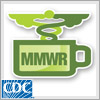A CUP OF HEALTH WITH CDC
Wildfires: A Growing Hazard in the U.S.
Wildfire-Related Deaths - Texas, March 12-20, 2006
August 24, 2007
[Announcer] This podcast is presented by the Centers for Disease
Control and Prevention. CDC – safer,
healthier people.
[Matthew Reynolds] Welcome to A Cup of Health with CDC, a
weekly broadcast of the
MMWR, the Morbidity and Mortality Weekly Report. I’m your host, Matthew
Reynolds.
In March 2006, residents in the Texas panhandle suffered through over a week
of
devastating fires that claimed 12 lives and damaged over $16 million in property.
Researchers from CDC investigated these fires. Dr. Dahna Batts was a member
of that
team and she’s here to discuss their findings and offer suggestions to
help prevent
similar tragedies. Welcome to the show, Dr. Batts.
[Dr. Batts] Thank you so much.
[Matthew Reynolds] The CDC does a lot to prevent disease
and promote health, as
many people know, but investigating fires? Why is CDC involved?
[Dr. Batts] CDC is involved because the environmental health
issues that a wildfire
presents are a preventable cause of death. So, as an environmental health agency,
in
addition to other areas of health that we investigate, wildfires could be a
big problem
and it is a preventable cause of disease and injury.
[Matthew Reynolds] Well, let’s talk about those fires.
Can you describe the ones that
swept through the panhandle? What happened?
[Dr. Batts] There was devasted fires in 2006 in Texas where
the wildfires did spread
throughout a region of Texas and cause a number of deaths. This was one of the
largest wildfires and tragically resulted in the largest number of human deaths
in the
civilian population in Texas history. So this particular incident was quite
devastating.
Many of the injuries and illnesses that occurred were due to smoke and haze,
as well as
some behaviors that, if the public wasn’t involved in, could have prevented
death.
[Matthew Reynolds] Most people who are hearing about this
story tend to think of it as
news, a tragedy certainly, and then move on without giving it another thought.
You’re
saying that’s a mistake?
[Dr. Batts] Yes, that would be a mistake. All wildfire-related
deaths and injuries are
potentially preventable. There are proven methods that home owners and responders
can take to protect themselves, as well as their home and their property, but
all of these
need to be accomplished prior to the wildfire starting.
[Matthew Reynolds] Well let’s talk about some of those
strategies. What should people
do to protect themselves and their families?
[Dr. Batts] People should really have a disaster preparedness
plan and an exit strategy
that would take effect under any type of emergency, especially a wildfire. They
should
really adhere to any warnings or evacuation orders that are administered. Creating
a
disaster plan, as well as a disaster supply kit, really does not take a lot
of time or effort,
but it is something that could be critical in saving your life in the event
of an emergency.
[Matthew Reynolds] What about protecting homes? A are there
things that people can
do to protect their homes, in addition to their families?
[Dr. Batts] To protect your home from a wildfire, it‘s
very important for you to keep any
combustible materials away from structures. You want to avoid the build up of
any
flammable material by cleaning roof surface and gutters regularly. Those are
two critical
steps that a person can do to protect their home from the effect of a wildfire.
[Matthew Reynolds] What should I do if I’m driving
down the road and the roadway is
suddenly filled with smoke?
[Dr. Batts] You should avoid traveling through a smoke filled
roadway at all costs. This
is one of the mechanisms that many of the individuals in this particular event
died. They
were in motor vehicles and involved in collisions or trauma episodes due to
driving on a
road where visibility was poor because it was filled with smoke.
[Matthew Reynolds] Dr. Batts, this information has been very
helpful. If people want
more information about evacuation plans and prevention suggestions for wildfires
and
other disasters, where should they go?
[Dr. Batts] They can go to their local health department
or local emergency
management agency website, as well as the CDC emergency website which is
www.emergency.cdc.gov for further guidance, as well as instructions on how to
prepare
for a number of different types of disasters.
[Matthew Reynolds] Thank you, Dr. Batts, for taking the time
to share this information
with our listeners.
[Dr. Batts] Your welcome; thank you very much for having
me.
[Matthew Reynolds] That’s it for this week’s
show. Don’t forget to join us next week.
Until then, be well. This is Matthew Reynolds for A cup of Health with CDC.
[Announcer] To access the most accurate and relevant health
information that affects you, your family
and your community, please visit www.cdc.gov.



